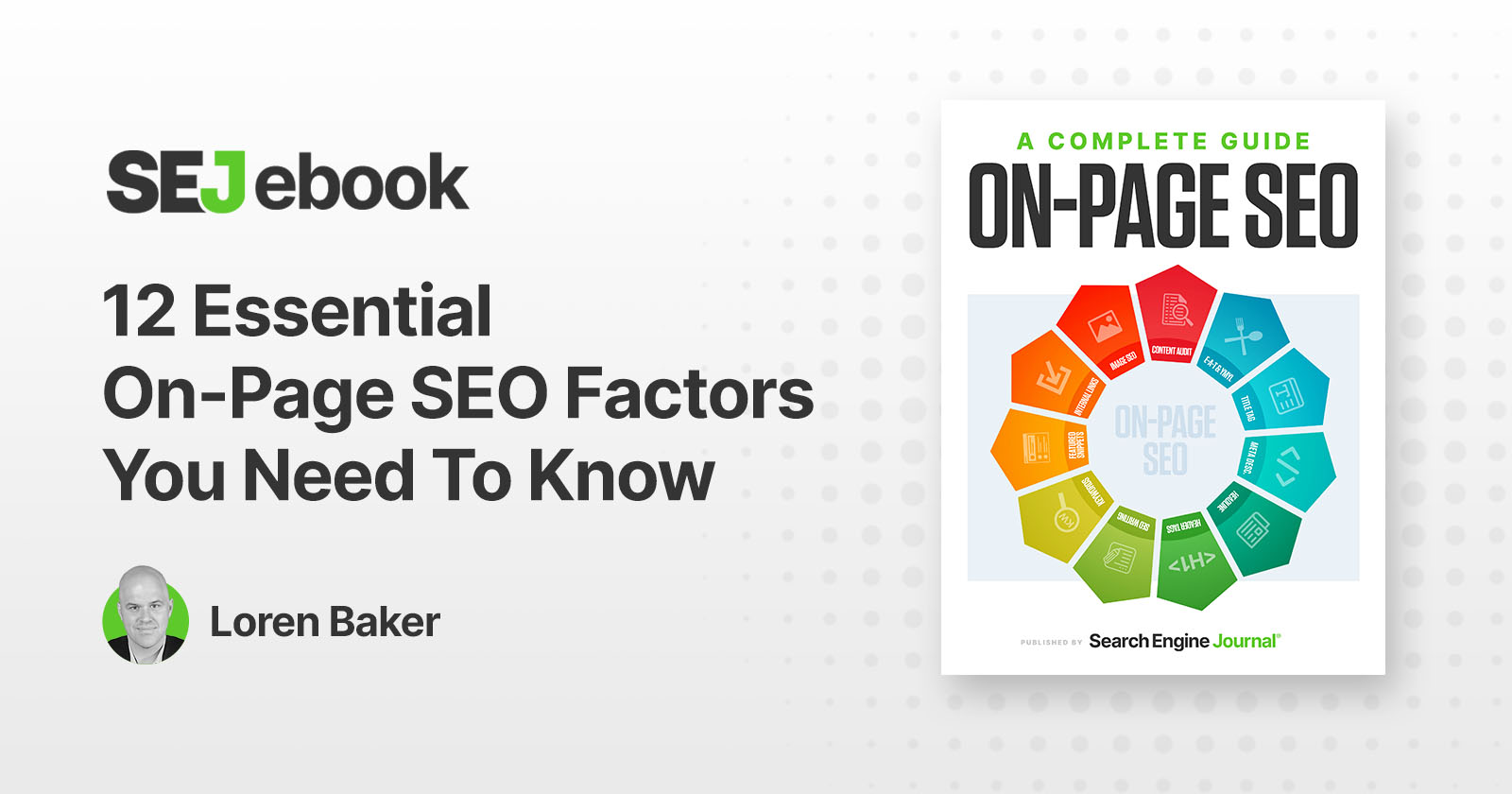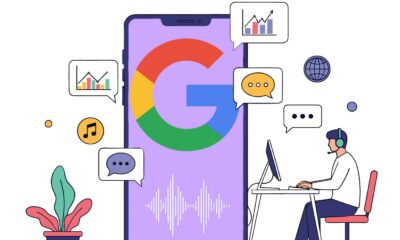SEO
12 Essential On-Page SEO Factors You Need To Know

Did you ever play Tetris? If so, you probably remember how there was no real way to “beat” the game. It basically just got faster and faster with every level.
In some ways, search engine optimization (SEO) is the same.
Not in that it has a catchy 8-bit soundtrack or that it rewrites your dreams, but in that, it never ends.
There’s no point at which you can sit back and relax, content that your site is at the top of search engine results pages (SERPs) once and for all.
Sure, you might have reached the pinnacle today, but an SEO pro’s work is never done.
Every change to Google’s algorithm or competitor content could knock you off that top spot, which means you have to keep up with changes.
And that means your on-page SEO needs to be on point. But before we dive into that, it’s important to have a high-level overview of how Google and other search engines work.
Search Engine Basics
Search engines send out crawlers, or spiders, to explore the internet. They follow links from one site to another, building a map of the content called a search index.
In the process of exploring sites, these crawlers are also evaluating their content, determining what kind of information it contains.
This data is then used by the search engine’s algorithm to determine how well the content of that specific site answers queries from users.
The better it answers the query, the more highly it will be ranked on the SERP.
In Google’s never-ending quest to provide better results to users, its algorithm is updated frequently. This inevitably leads to changes in rankings, which then requires someone to optimize the website to improve or ensure rankings.
What Is On-Page SEO & Why Is It Important?
On-page SEO, which is sometimes called on-site SEO, is the process of tweaking a page’s content, tags, and internal links to improve search visibility and increase traffic.
In other words, it’s a means of optimizing your website to help search engines better understand your website.
And this, of course, comes with a whole host of benefits.
The first is in the amount of traffic.
The first five organic results on a search page get 67.60% of all clicks. The next five account for only 3.73%. And it drops from there. So, if you want to get traffic, you need to be near the top.
Secondly, high-ranking sites have much better click-through rates (CTR). The first Google mobile search result has an average organic CTR of 26.9%.
Now consider that 92.4% of internet users who search on their mobile phones for something nearby visit that business the same day and you can start to see the impact organic SEO can have on your bottom line. And on-page optimization is an important factor in your organic ranking.
Hopefully, by this point, you’ve grasped the importance of on-page SEO. Now it’s time to get started. Let’s dive right in…
12 Essential On-Page SEO Factors
On-page SEO can be broadly divided into three categories: content, HTML, and website architecture. We’ll look at each individually.
Content
You’ve heard it before: Content is king.
SEO without it is like a beautiful new sports car without an engine – it might look nice, but it’s going nowhere. But, not all content is not created equal.
Here are the content factors you need to consider to maximize your on-site SEO:
1. E-A-T
One way Google weights your site is based on E-A-T, or expertise, authoritativeness, and trustworthiness.
In 175 pages of Google Search Quality Guidelines, it’s mentioned 135 times, which should be an indication of the role it plays in the search engine’s algorithms.
While Google has only confirmed a few elements of E-A-T (PageRank and links), it’s generally accepted in the SEO field that on-page signals play a big part in its evaluations.
For a deeper dive on E-A-T, read this piece.
2. Keywords
The most basic way to tell them your website’s content answers a user’s question is in the language you use.
Pages that feature the keywords used in a query, whether in the body, headings, or both, are more likely to be relevant to the search.
Sometimes this is easy to determine. If you’re optimizing the website of a furniture store, you’re probably going to want to include keywords like [sofa], [dining room set], and [end table].
If it’s a specialized furniture store, you’ll want to make sure you’re including long-tail keywords like [contemporary art-deco sideboards].
In short, you need to know what your target customers are searching for and create content that includes these terms. It’s always a good idea to do research, so you’re not missing any opportunities.
Get started by downloading our ebook on keyword research.
3. SEO Writing
Creating the type of content that both prioritizes search engines and converts human visitors to your site is something of an art.
Unless you’ve done it before, it can be quite challenging to write copy that reads well and still adheres to SEO best practices.
We have an entire piece dedicated to helping you master the art, but some of the key takeaways include:
- Emphasize readability: Your content should be easily scannable, so users can quickly find the information they’re looking for.
- Don’t overuse keywords: Also known as keyword stuffing, this technique was used in the past by unscrupulous SEO professionals to game the system, Google takes a dim view of sites that overuse keywords. If you’re caught doing this, your page could be demoted in SERPs or even removed altogether.
- Keep sentences and paragraphs brief: If you’ve ever clicked on a webpage only to be assaulted by an unbroken wall of text, you know how hard it is to read lengthy pieces of copy. Avoid driving users away by keeping your sentences and paragraphs short.
- Use subheadings: Subheads stand out because of their size, attracting attention from people who are scanning your page. Use an ample amount in your content to guide readers down the page.
- Use bulleted lists: This may feel very meta, but bulleted lists are a good way to break information down into easily digestible chunks. Use them whenever they make sense.
4. Visual Assets
Using images, videos, and infographics do more than making your page visually interesting to visitors. It also gives you opportunities to boost your SEO.
More than 36% of consumers use visual search when they’re doing online shopping, which means if you’re not using images, you’re missing out on traffic.
Make sure you’re optimizing your accompanying text whenever possible.
Be aware of your image file sizes to prevent slow loading. Make your images shareable to identify opportunities for backlinking, which can help boost your E-A-T.
HTML
HyperText Markup Language or HTML is the code used to structure your webpages and their content.
They tell the user’s browser what to show and where to show it. And it tells search engines what your page is all about and where they should rank you.
Here are the on-page SEO HTML factors you need to consider:
5. Title Tags
This is one of those areas where it’s important to focus on the details.
On its own, this snippet of code that allows you to give a webpage a title probably isn’t going to have you shooting up SERP rankings.
But in context with other on-page elements (like the ones discussed here), it can help you build context and demonstrate your site’s relevancy.
For a more thorough look at how to optimize your title tags, read this.
6. Meta Description
Right now, a veteran SEO professional is throwing up her hands at the screen. “Oh, come on,” she’s saying, “Everyone knows meta descriptions aren’t an SEO ranking factor.”
She’s only partly right. While it’s true there is a lot of evidence against meta descriptions as a ranking factor, she’s wrong about everyone knowing that.
And don’t let negative Nancy here dissuade you from adding them to your site.
Despite their relative lack of use in SEO, they do offer two key benefits: They can help Google understand what your web page is all about, and more importantly, they have an outsized influence on your CTRs.
Better meta descriptions give searchers a better understanding of what your page is all about, which in turn leads to more clickthroughs. So, don’t neglect them.
7. Image Optimization
We already briefly touched on the importance of visual assets on your page, but now it’s time to look more closely at their technical aspects.
Here are some tips to help optimize yours:
- Include SEO-friendly alt tags.
- Choose the right format and file size for fast loading.
- Customize file names instead of using something like IMG_08759.
- Ensure your images are mobile-friendly.
Once again, we have an excellent resource for more in-depth information on HTML image optimization. Read it here.
8. Geotagging (For Local Search)
It may be a global economy, but most business is still done at a local level. Connect with the people in your neighborhood by optimizing your on-page local SEO.
While this is less important for mega-corporations like GMC or Pepsi, for small- and medium-sized businesses, this is their bread and butter.
There are three main SEO tactics to consider when focusing on local traffic:
- Optimizing local listings and citations including name, address, and phone number (NAP), website URL, and business descriptions, using third-party apps, and getting reviews.
- Optimizing your local content, including accommodating for “near me” searches, providing location-based content, or buying a local website or blog.
- Optimizing and building links with other local businesses and organizations.
Be sure to include the name of your target location in your keywords and put them in your content wherever they fit.
For more information on building your own geotagging SEO strategy, read this.
Website Architecture
Having a well-structured website is important for two reasons: First, a website laid out in a logical manner will be crawled more effectively by search engines, and secondly, it will create richer user experiences.
Here are the factors to consider when optimizing your site’s architecture:
9. Site Speed
A clunky, slow-loading site does more than frustrate and drive away visitors – it actually hurts your search ranking too.
Search Engine Journal took a deep dive into the effect a page’s loading time has on SEO and confirmed page speed is a ranking factor in search results.
However, what minimum speed your site needs to meet is constantly changing.
It can currently be met by meeting Google’s Core Web Vitals minimum threshold. If your site isn’t currently meeting these standards, there are several steps you can take, including:
- Enabling compression.
- Reducing redirects.
- Optimizing images.
- Leveraging browser caches.
10. Responsive Design
In 2016, mobile search volume surpassed desktop for the very first time. And in the years following, that number has only grown.
Mobile now accounts for more than 56% of all internet usage, with tablets contributing another 2.4%.
Because more users are on mobile devices, Google followed the logical path and began to prioritize sites with responsive designs in mobile search rankings.
This mobile-friendly update only impacts search results performed on mobile devices, and while it’s still possible to rank in these results without responsive design, Google strongly recommends sites have a mobile version.
You can read more about the affect site responsiveness has on search results here.
11. URL Structure
There was a time when URLs played a large role in SEO. Professionals would make sure their keywords were included in web addresses to help them rank higher.
But Google, doing what Google does, changed the algorithm. And what was once so important to rankings, now plays a much smaller role.
That’s not to say it doesn’t matter. Search engines are still including your URLs in your overall score – they just don’t hold the same prominence they once did.
However, there is evidence they play a role in a site’s initial ranking, and some professionals believe they’re used to group pages. What this means is, that while they shouldn’t be your top SEO priority, you don’t want to ignore them either.
Read more about how URLs factor into Google rankings here.
12. Links
Remember E-A-T from way back at the beginning of this article?
One of the best ways your website can establish expertise, authoritativeness, and trustworthiness is through links from other reputable websites.
Think of it this way: Who would you rather trust your 401(k) to – a financial advisor who manages Warren Buffet’s portfolio or your cousin Jimmy, who lives in your aunt’s basement? Jimmy might do a fine job; he could potentially even outperform Buffet’s guy. But he just doesn’t have the credibility that comes with a strong co-sign.
Links work in the same way.
There are three main types you need to know about for SEO:
- Internal links – or ones that direct to another page on your website like this one.
- Outbound links – also known as external links, these are the links that point to a site on a different domain, like this one pointing to Google’s SEO page.
- Inbound links – sometimes called backlinks, these are links from other websites pointing to your page.
Of the three, inbound links are by far the most important. They provide the biggest SEO benefit, but they’re also the hardest to obtain.
There are a variety of methods SEO professionals use to generate quality incoming links, including using social media, creating sharable infographics, and even just asking for backlinks.
But beware: Not all inbound links are helpful. Some, especially those coming from link farms, forum posts, and guestbooks, can be fake links intended to cheat the rankings system. If you don’t disavow these, it can hurt your ranking.
Here’s information on how and when you should disavow links.
On-Page SEO vs. Off-Page SEO
We’ve talked a lot about on-page SEO, but there’s also something known as off-page SEO. The difference, as you could probably tell by the names, is where it happens.
On-page SEO is everything you can do internally to boost your rankings, including keyword optimization, meta descriptions, title tags, alt text, and website structure.
Off-page SEO is all the things that happen externally that impact your site’s rankings. This includes backlinks, E-A-T, local SEO, social media mentions, and pay-per-click.
Obviously, you have a lot more control over your on-page SEO, but it’s important to keep off-page SEO in mind as well – you need both to get where you want to go.
But, you should first focus on building a good, relevant webpage that’s fully optimized for search engines before you begin sinking a lot of resources into building links and promoting your site.
On-Page SEO Is An Ongoing Process
At the end of the day, search engine optimization boils down to one thing: Finding the best way to provide valuable information to searchers, and ensuring your website is at the top of SERPs.
Your goal is to provide richer experiences to users, while simultaneously demonstrating your value to search engines. Luckily, these two go hand-in-hand. And they start with on-page optimization.
Start with what you can control, carefully evaluating your current site for weaknesses and opportunities for growth.
Get all your on-site ducks in a row and you’ll start to see results – including an organic improvement in off-site factors.
Just remember, SEO, like Tetris, is never done. But keep reading and keep working, and you’ll get the results you deserve.
Featured Image: Paulo Bobita/Search Engine Journal



















You must be logged in to post a comment Login